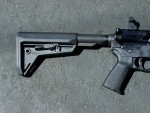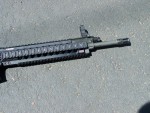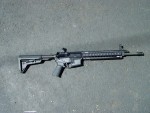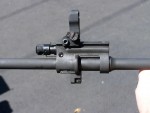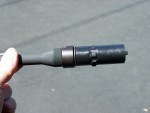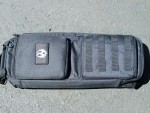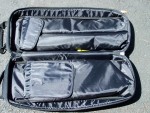I’m a fan of the AR-15 type of rifles. I always have been. So, when some gun makers started coming out with AR-15s that had a gas piston, instead of the direct gas impingement system, I tested several of them. I think we could have a debate all week long as to the merits of the gas piston system versus the direct gas impingement system and we couldn’t change one another’s minds. There is absolutely nothing wrong with the direct gas impingement system, other than your AR really gets dirty, in short order. Yes, I’m aware there were problems with the first M-16s (military select-fire versions of the semiauto AR-15) when they were first shipped to Vietnam. However, there was stupid thinking on the part of someone who said the guns didn’t need to be cleaned very often and no cleaning kits were even supplied. Plus, there was a problem with the gun powder used in the ammo of the first M-16s. Once these problems were corrected, the M-16 ran fine, so long as you kept them halfway cleaned and lubed, just like any other gun.
A couple of years ago, Ruger came out with their first version of a gas piston AR type of rifle, called the Ruger SR-556, and it was an immediate hit with gun owners. I did an article on the SR-556 for SurvivalBlog.com and was very favorably impressed with my sample. Ruger had a hard time keeping up with demand. The Ruger gas piston system is proprietary to their guns. You can’t interchange parts with any other gas piston AR, and this seems to be typical of gas piston ARs, no matter who makes them.
I do like the way the SR-556 gas piston adjustments can be made with a simple .223/5.56 round. Simply slide the bullet end into the adjustment knob and turn it from one setting to another. Ruger ships their SR-556 rifles with the setting on the “2” position. Quite honestly, the gun ran fine, no matter what ammo I ran through it or how dirty it got. Still, I played around with the different adjustments from the “0” position to the “3” position. You can find all this information in my previous SR-556 article on SurvivalBlog.com
Today, we’re taking a close look at the Ruger SR-556 Takedown version. Ruger did a bang-up job on it. A few specs are in order first. The SR-556 comes with a newer style butt stock that is still adjustable, but I like the shape and feel of the new butt stock a lot better than the older version. There’s nothing wrong with the older version, but the newer one is better in my opinion; it’s stronger, to be sure. The SR-556 Takedown has folding “iron” sights in the front and rear. They are actually made of steel not iron, but for whatever reason we always call them “iron” sights. Go figure. Plus, the sights are readily adjustable without any problems. The barrel is 16.1 inches long, just like the original with a 1:9 right hand twist. The finish is manganese phosphate/hard coat anodized, and the gun weighs in at 7.6 lbs. You can read all the specs on the Ruger website. I hate boring our readers with too many specs when they can read about it themselves.
Where we have a drastic change is with the barrel assembly. The Takedown SR-556 comes set-up with the standard .223/5.56 barrel. However, you can swap out the barrel with one chambered in .300 AAC Blackout. Yes, you read that right! Just by changing barrels, you can change calibers; no other changes are required. You use the same bolt and bolt carrier, and you can technically use the same magazines. However, with the .300 AAC Blackout conversion barrel, Ruger sends you two magazines that are marked .300 Blackout. I, however, have one of the first conversion set-ups and my magazines weren’t marked with the .300 Blackout on them.
So, how easy is it to change from one caliber to another? Actually, it’s VERY easy. Simply slide the locking bar on the end of the fore arm, twist and pull the barrel out, and reverse the order to put in the new barrel. It’s just that quick and simple. Now, the .300 AAC Blackout barrel doesn’t come with the gun; this is ordered separately, but I’m hoping that, and I mentioned it to Ruger, maybe they could offer the SR-556 with the .300 AAC Blackout barrel installed, instead of the .223/5/56 barrel. Those of us who already have enough ARs in .223/5.56 might want this gun just in .300 AAC Blackout. Or, we might want the Ruger AR-556 in .300 AAC Blackout instead of .223/5.56. It’s something to think about here, Ruger.
The takedown feature on this gun provides repeatable accuracy. I removed both barrels several times, numerous times for that matter, and the bullet point of impact didn’t change at all. Of course, when you change from one caliber to another, the point of impact changes; the .300 Blackout shoots heavier .30 caliber bullets. For my testing, I didn’t change the sight adjustments at all. I just let the different calibers group where they did. I was testing for accuracy, not setting up the sights for different points of impact.
I also wanted to mention the new Ruger Elite 452 AR trigger they are installing on the Takedown. It is a two-stage trigger that is smooth; yet it has a crisp release that is 4.5 lbs. I hope Ruger starts installing this in all their AR-style rifles. It is a great trigger pull, to be sure. Again, for all the specs on the Takedown, go to Ruger’s website.
The SR-556 Takedown does come in a nice black ballistic nylon backpack, with the rifle in the takedown set-up. People wouldn’t know you were carrying a rifle in this backpack. Just remove the Velcro Ruger patch on the back of the backpack and you’re good to go. It only takes a minute or two to reassemble the rifle. It’s a nice way to pack a gun in the trunk of your car, or if out hiking no one would know you had a rifle in that backpack. The pack is very well-made, too. It’s super nice!
I had the SR-556 Takedown for a month, before the .300 Blackout conversion barrel arrived, so I had more than a few shooting sessions. Of course, it all took place during the hottest part of our summer and I don’t tolerate heat, especially in the upper 90s and 100 range. I took copious notes, because my testing was spread out over the course of a month.
From Black Hills Ammunition, I had their .223 Rem in 55-gr FMJ, 55-gr Soft Point, 60-gr Soft Point, 62-gr Barnes TSX and their 68-gr Heavy Match Hollow Point. In 5.56mm, I had their 69-gr Open Tip Match. I also received some new 5.56mm ammo from Ruger after my initial testing, and that was their new 69-gr Sierra TMK and their 70-gr Hornady GMX loads. So, it was back to the range for more testing, when I thought I was all done shooting. What a hard job, but someone has to do it– the sacrifices I make. LOL
There were zero malfunctions with any of the Black Hills ammo, and all shot great using open sights. I was only shooting at 50 yards this time, and I was getting groups less than two inches using a rest over the hood of my pick-up truck. The 60-gr Soft Point load gave me a one-inch group, so long as I did my part, and I did this several times. A smart writer knows when to quit; you quit when you’re at your best. After that, your groups start to open-up and you get frustrated that you can’t keep on getting those little groups all day long.
Now, here’s something of interest; the 5.56mm 69-gr Open Tip Match load was also giving me groups close to the one-inch mark, so long as I was on my game. However, when I received the 5.56mm 69-gr Sierra TMK and 70-gr Hornady GMX loads, the SR-556 Takedown’s 1:9 barrel twist just didn’t like them at all. The groups were all over the place. Now, this isn’t the fault of the gun or the ammo; it’s the barrel twist. On the Ruger AR-556 rifles, the barrels have a 1:8 barrel twist, and I had no problems with these newest 5.56mm rounds. What I found really interesting is that the 69-gr Open Tip Match 5.56mm load shot fine, but the same 69-gr weight bullet with the Sierra TMK load wouldn’t group. So, you should always test any ammo you plan on using, first of all to make sure it functions and secondly for accuracy.
When it comes to barrel twists in ARs, it just depends on the particular rifle and the bullet weights you are using. Many ARs with a barrel twist of 1:9 won’t shoot anything with any sort of accuracy over 62-grs; some will, and some just won’t. It depends on the gun itself and the ammo you are using. If you want to shoot heavy .223 or 5.56 bullets, you should go with a 1:7 inch barrel twist. Who knows, maybe Ruger will offer conversion kits for these Takedown rifles with different barrel twists. Still, I found it a little bit strange that this gun would shoot and group the 69-gr Open Tip Match round, but the 69-gr Sierra TMK round wouldn’t group. One would assume (and we shouldn’t do that should we?) that the bullets are the same weight, so they should shoot about the same, right? Nope!
Black Hills sent me some of their .300 Whisper 125-gr Open Tip Match ammo. I actually received the ammo several weeks before I got the Takedown .300 AAC Blackout barrel conversion. Now, to be sure, you can shoot .300 Whisper through a rifle chambered in .300 AAC Blackout, however, the reverse isn’t always true. You really shouldn’t shoot .300 AAC Blackout in a rifle chambered in .300 Whisper. They are “that” close to being the same ammo, but there is a silly millimeter difference in the specs of the rounds. I know some people don’t have any problems shooting .300 AAC Blackout in a rifle chambered in .300 Whisper, so proceed with caution. Black Hills also manufactures a 220-gr subsonic .300 Whisper round, but it won’t function the action, if you don’t have a suppressor on the end of the barrel, so I didn’t request any of the heavier .300 Whisper ammo from them for my testing.
Some months back, I received a Ruger Mini-14 in .300 AAC Blackout, and I’m here to tell you I simply fell in love with this round. It is actually a bit more potent than the 7.62X39 round that is used in the AK-47. Again, the only ammo I had in to shoot in the Ruger Mini-14 in .300 AAC Blackout was the Black Hills .300 Whisper 125-gr OTM round, and it shot great. There is just “something” about the .300 AAC Blackout/.300 Whisper that draws me to it; it’s nothing I can really put my finger on though, strange! The round is super accurate, and it can be used for hunting medium-sized game, and I understand it is great on wild pigs, too.
Once the .300 AAC Blackout barrel was installed on the SR-556 Takedown, I ran out to the range and used the Black Hills .300 Whisper, 125-gr Open Tip Match ammo. Once again, my shooting was done only at 50 yards because of weather conditions– extreme fire danger. I had zero problems keeping all those rounds under one inch. The gun can shoot, and the ammo was second to none. Then again, I expect nothing less from Black Hills Ammunition. I was more than a little impressed with the .300 Whisper ammo in the Takedown. I have since begged Jeff Hoffman, who co-owns Black Hills Ammunition with his lovely wife, Kristi, for some more of their .300 Whisper ammo, just for killing rocks and paper. They happily sent me a good supply for further shooting.
I have zero complaints about the Ruger SR-556 Takedown that I can think of. As I suggested to Ruger, I’d like to see if offered along with their AR-556 in .300 AAC Blackout to start with, and if a person wants to swap out that .300 barrel in the Takedown version for one in .223/5.56 they can. If Ruger offered their AR-556 in .300 Blackout, I’d buy one in an instant. I have no complaints with my Ruger Mini-14 in .300 Blackout, but still I’d buy their AR-556 in .300 Blackout if it was offered.
The .300 AAC Blackout is rapidly gaining acceptance for a round that can outperform the .223/5.56, especially when more power is needed at longer distances. The .300 Blackout will outperform the .223/5.56 out past 450 yards and hit harder and hit with a .30 caliber bullet instead of the lighter .222/5.56 will, and I didn’t even mention recoil. I honestly didn’t notice much more recoil between the .223/5.56 rounds and the .300 Whisper rounds I fired. I guess there was a bit more recoil with the bigger rounds, but I honestly didn’t notice it during my firing.
One of the benefits with the .300 AAC Blackout round is that it fits into AR-sized guns. There’s no changing out the bolt/bolt carrier, just a different barrel, and you can use the same magazines if you want. Ruger, on the side of caution, sends two magazines with the .300 Blackout conversion with the mags clearly marked as to .300 Blackout. Of course, as mentioned, mine didn’t have any markings. Then again, it was one of the first .300 Blackout conversion kits shipped.
Full retail on the Ruger SR-556 Takedown is $2,049.00. To be sure, it is spendy, but there are many other piston-driven AR-style rifles in only .223 or only in .300 Blackout that are a lot more money. Ruger has always offered blue collar prices on their guns. While I’ll readily admit that this is a lot money, the gun is worth it, especially when you consider that you can change calibers in a minute with the conversion kit, and it sells for under $500, too. I’m keeping my sample, and now I have to find a way to pay for it. Maybe I’ll declare it as a Christmas present to myself. How much can the wife complain? I always tell her that, “I just need one more gun…” and it’s still as true today as it was when I first told her that, many years ago. Check out the Ruger SR-556 Takedown at your dealer, if you can find one. They are still in short supply, due to great demand.
– Senior Product Review Editor, Pat Cascio










